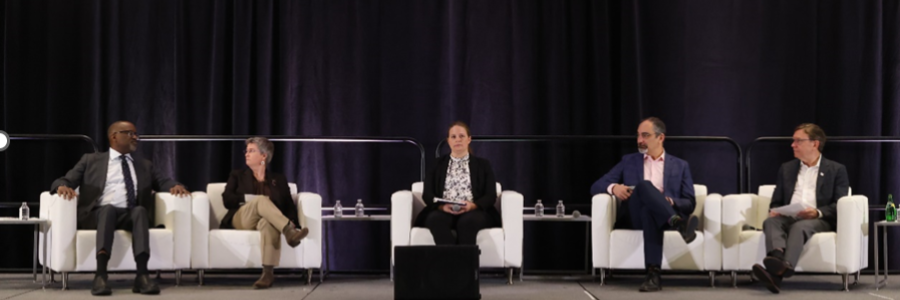Bridging the Gap: Why Translational Research is Key to Unlocking Cell & Gene Therapy Innovation
Jeffrey S. Chamberlain, PhD - July 22, 2024
Dr. Chamberlain recapped an Annual Meeting fireside chat, "Supporting Translational Science and Transformative Therapies." If you attended the meeting, watch it on demand through Aug. 1!

As the cutting-edge field of cell and gene therapies continues its rapid advancement, translational research requires a renewed focus. Translational science forms the vital link between early-stage basic research discoveries and their ultimate application through clinical studies to improve patient lives. However, this critical bridging stage can often be overlooked and underfunded compared to basic research or late-stage clinical trials.
At the recent ASGCT Annual Meeting session "Supporting Translational Science and Transformative Therapies," leaders from organizations like the National Institutes of Health (NIH) highlighted major initiatives to bolster translational efforts for cell and gene therapies. The National Heart Lung and Blood Institute (NHLBI)'s Cure Sickle Cell Initiative, National Center for Advancing Translational Science (NCATS) programs like the Rare Disease Clinical Research Network, the National Institute of Neurological Disorder and Stroke (NINDS)’ Ultra-rare Gene-based Therapy (URGenT) Network, and the newly-formed Advanced Research Projects Agency for Health (ARPA-H) are all channeling resources into de-risking and accelerating the transition from promising early findings to clinical testing of potentially curative therapies.
The audience Q&A highlighted the importance of practical commercialization support - with initiatives like the NIH's Catalyze program offering resources to help bridge the gap between research and market readiness. Moreover, addressing medical mistrust and fostering partnerships in low- and middle-income countries (LMICs) were emphasized as essential steps towards making advanced therapies globally accessible. ARPA-H's focus on developing innovative solutions, such as using non-refrigerated materials or in vivo approaches, could be instrumental in overcoming technical barriers that often hinder the delivery of these therapies in resource-limited regions. By providing comprehensive support that spans from general commercialization to tailored solutions for underserved areas, these efforts have the potential to unlock the full potential of advanced therapies worldwide through translational science.
This federal focus on translational science is crucial, especially now. As our fundamental understanding of genetic medicine rapidly expands, the bottleneck shifts to effectively translating those insights into patient-ready applications. Challenges span from optimizing delivery systems, scaling manufacturing, navigating regulatory hurdles, and ensuring patient access. Translational science addresses the "valley of death" in biomedical research, where promising basic science innovations often do not progress due to lack of resources, ability, or infrastructure to scale up. Without robust translational research, many potentially transformative therapies might never reach patients.
At this stage of the field, no one entity can drive it forward … There is a great power and importance in a convening organization like this, that can bridge across the ecosystem.
Dr. Gary Gibbons, NHLBI
ASGCT can play a vital role in supporting this translational bridging. As a society bringing together the full network of scientists, clinicians, companies, regulators, and patient advocates, ASGCT is uniquely positioned as a connector hub.The Society can foster collaborations, highlight best practices, and advocates for increased focus and funding for the critical translational space. To continue the conversation with a wider range of stakeholders, be sure to check out ASGCT’s Policy Summit, this September in Washington DC. By elevating translational science alongside pioneering research and late-stage trials, we can realize the full transformative potential of cell and gene therapies.
Registered attendees can watch all sessions on the meeting platform through Aug. 1.
Dr. Chamberlain is immediate Past President of ASGCT.
Related Articles
Maria Santaella, PhD (c), MSN, RN-BC, CPHON serves as the Vice President of Research for the National Bleeding Disorders Foundation. During the workshop she spoke on clinical trial enrollment by sharing strategies to address barriers in recruiting.
Annual Meeting 2024
Inclusive Trial Design Amplifies Patient Voices and Drives Meaningful Outcomes
Samuel Hughes, MBA, St. Jude Children's Research Hospital - June 18, 2024
Annual Meeting 2024
Patient Advocates Connect at the Annual Meeting
Ali Kujawski, Senior Patient Outreach Manager - June 12, 2024
Annual Meeting 2024
Congratulations to These #ASGCT2024 Poster Presenters
View the full abstract collection - May 17, 2024
Annual Meeting 2024
Diversity, Equity, and Inclusion Within Gene and Cell Therapy: Where Does It Stand?
Christina Fuentes, PhD - May 09, 2024